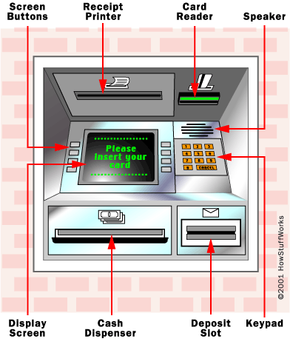Parts of the Machine
You're probably one of the millions who has used an ATM. As you know, an ATM has two input devices:
- Card reader - The card reader captures the account information stored on the magnetic stripe on the back of an ATM/debit or credit card. The host processor uses this information to route the transaction to the cardholder's bank.
- Keypad - The keypad lets the cardholder tell the bank what kind of transaction is required (cash withdrawal, balance inquiry, etc.) and for what amount. Also, the bank requires the cardholder's personal identification number (PIN) for verification. Federal law requires that the PIN block be sent to the host processor in encrypted form.
And an ATM has four output devices:
Advertisement
- Speaker - The speaker provides the cardholder with auditory feedback when a key is pressed.
- Display screen - The display screen prompts the cardholder through each step of the transaction process. Leased-line machines commonly use a monochrome or color CRT (cathode ray tube) display. Dial-up machines commonly use a monochrome or color LCD.
- Receipt printer - The receipt printer provides the cardholder with a paper receipt of the transaction.
- Cash dispenser - The heart of an ATM is the safe and cash-dispensing mechanism. The entire bottom portion of most small ATMs is a safe that contains the cash.
